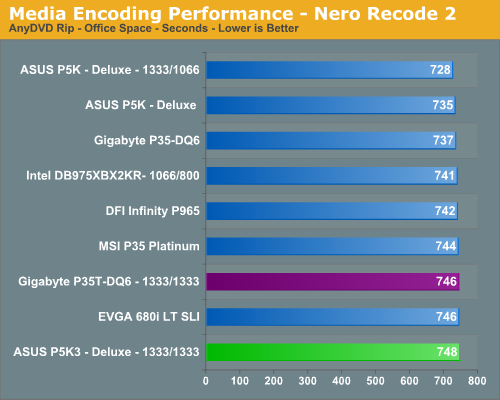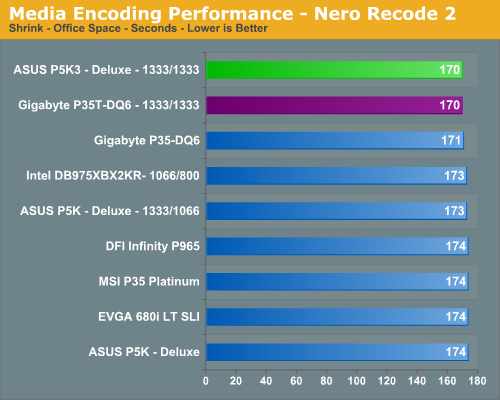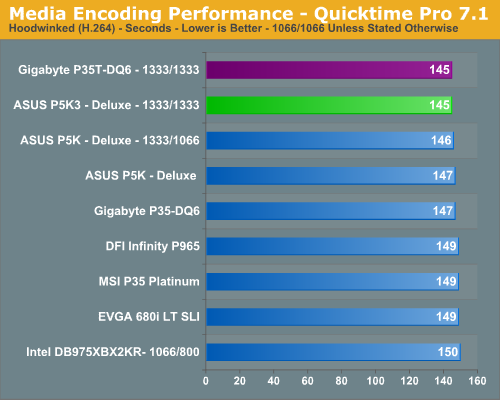Gigabyte GA-P35T-DQ6: DDR3 comes a knocking, again
by Gary Key on May 30, 2007 2:00 AM EST- Posted in
- Motherboards
Media Encoding Performance
We are utilizing an updated video encoding test suite for this article that includes AnyDVD, Nero Recode 2, Windows Media Encoder 9, and QuickTime Pro 7.1.
Our first encoding test is quite easy - we take our original Office Space DVD and use AnyDVD Ripper to copy the full DVD to the hard drive without compression, thus providing an almost exact duplicate of the DVD. We then fire up Nero Recode 2, select our Office Space copy on the hard drive, and perform a shrink operation to allow the entire movie along with extras to fit on a single 4.5GB DVD disc. We leave all options on their defaults except we turn off the advanced analysis option. The scores reported include the full encoding process and are represented in seconds, with lower numbers indicating better performance.


The AnyDVD Rip results do not show our DDR3 boards performing well against the DDR2 boards, especially against the same chipset. Even though memory timings are higher, the increased bandwidth and latency would normally bring the DDR3 boards within range of the DDR2 boards in a test that is CPU throughput and disk intensive. The 3% performance deficit is unusual, indicating that the high volume of data being transferred may cause memory latencies to be a more significant factor. The Shrink results are more in alignment with the DDR3 boards showing up to a 2% difference in this test.
Our next test has us converting our day at the beach AVI file into a high definition WMV file suitable for our Grandparents to view on their new HDTV. We ensured our quality settings were set to High Definition. The balance of options is set to standard settings and then we let this program do its magic. We are reporting the numbers in seconds to complete the conversion.

We see the boards with the best memory bandwidth and latency performance once again leading in a test that still favors the DDR2 boards. Our DDR3 boards finish in the middle of the pack. The overall difference in scores between all boards is a rather small 1.3%.
Next on the list is our QuickTime Pro 7.1 test that will convert our newly downloaded .MOV file into a plasma screen pleasing H.264 format. We ensured our quality settings were set to their highest levels and then let the horses loose. The values reported are in seconds for the conversion time, with lower numbers being better.

The DDR3-1333 platforms have a slight advantage in this test although the differences are truly minimal. Outside of the MSI board, all of the P35 boards are scoring slightly faster than the older chipsets, and the total range of scores differs by 3.5%.
We are utilizing an updated video encoding test suite for this article that includes AnyDVD, Nero Recode 2, Windows Media Encoder 9, and QuickTime Pro 7.1.
Our first encoding test is quite easy - we take our original Office Space DVD and use AnyDVD Ripper to copy the full DVD to the hard drive without compression, thus providing an almost exact duplicate of the DVD. We then fire up Nero Recode 2, select our Office Space copy on the hard drive, and perform a shrink operation to allow the entire movie along with extras to fit on a single 4.5GB DVD disc. We leave all options on their defaults except we turn off the advanced analysis option. The scores reported include the full encoding process and are represented in seconds, with lower numbers indicating better performance.


The AnyDVD Rip results do not show our DDR3 boards performing well against the DDR2 boards, especially against the same chipset. Even though memory timings are higher, the increased bandwidth and latency would normally bring the DDR3 boards within range of the DDR2 boards in a test that is CPU throughput and disk intensive. The 3% performance deficit is unusual, indicating that the high volume of data being transferred may cause memory latencies to be a more significant factor. The Shrink results are more in alignment with the DDR3 boards showing up to a 2% difference in this test.
Our next test has us converting our day at the beach AVI file into a high definition WMV file suitable for our Grandparents to view on their new HDTV. We ensured our quality settings were set to High Definition. The balance of options is set to standard settings and then we let this program do its magic. We are reporting the numbers in seconds to complete the conversion.

We see the boards with the best memory bandwidth and latency performance once again leading in a test that still favors the DDR2 boards. Our DDR3 boards finish in the middle of the pack. The overall difference in scores between all boards is a rather small 1.3%.
Next on the list is our QuickTime Pro 7.1 test that will convert our newly downloaded .MOV file into a plasma screen pleasing H.264 format. We ensured our quality settings were set to their highest levels and then let the horses loose. The values reported are in seconds for the conversion time, with lower numbers being better.

The DDR3-1333 platforms have a slight advantage in this test although the differences are truly minimal. Outside of the MSI board, all of the P35 boards are scoring slightly faster than the older chipsets, and the total range of scores differs by 3.5%.










22 Comments
View All Comments
SirJoe - Saturday, June 2, 2007 - link
this is cool for you computer buffsGooger - Saturday, June 2, 2007 - link
I just did a google search for XMS3 and the only merchant to have it in stock at the bargain price of $599 is Tiger Direct! Yikes, I think I will wait a while untill the price of DDR3 becomes competitive with DDR2.AdamK47 - Wednesday, May 30, 2007 - link
Sorry Gigabyte, I just can't see myself ever buying a board with pink memory slots. Shoulda stuck with the blue.Stele - Friday, June 1, 2007 - link
"Pink it's my new obsessionPink it's not even a question..."
:D Sorry, couldn't resist the temptation :P
yacoub - Wednesday, May 30, 2007 - link
Thank you especially for the note about larger heatsinks being very difficult to mount and the associated image of the back of the motherboard so folks can see what they face if they have a heatsink that requires connecting a backing plate (as most of the larger ones do).yyrkoon - Wednesday, May 30, 2007 - link
What annoys me, is that every Gigabyte motherbord review has this same 'annoyance' written in. Come now fellas, you can only say it about 500 times, beore it starts getting old, and how hard is it really to press two keys in combination ? Gigabyte obviously is doing this for a reason, and if it takes me writting this comment to point that out, well, I just dont know . . .
Saying something like: 'You will need to press cntl + F1 to access the 'protected' portion of the BIOS . . .' Would sounds less critical, would not come off as negativity, and would keep you guys from sounding lazy . . .
TA152H - Wednesday, May 30, 2007 - link
It's not hitting the keys that is the problem, it's remembering to do it. When you have loads of computers with motherboards, it's nice if they have a standard way to access features, instead of adding an inane key sequence like CTRL-F1. It is annoying, because four years down the road if you have to work on this motherboard, for whatever reason, you have to try to remember this bizarre and otherwise trivial detail. Standards are nice, especially when following them doesn't involve a tradeoff.yyrkoon - Thursday, May 31, 2007 - link
Yeah, well I personally have a bad memory, but after reading countless Gigabyte motherboard reviews from AT here, I do not think I will ever forget this key combination.Anyhow, this is one reason why when given the chance I always opt for ABIT boards, while other may opt for Asus, Gigabyte, whatever. Once you become used to a given OEM BIOS Layout, it is hard to make a change in OEMs without suffering a bit in the knowledge department(at least temporarily).
*yyrkoon hugs his NF-M2 nView . . .
TA152H - Saturday, June 2, 2007 - link
Keep in mind, not everyone buying a motherboard from Gigabyte is going to be reading these articles, and proper journalism dictates they don't depend on people knowing every previous article, so they appropriately bring it up. Before you remark what's the point in them mentioning it for people that don't read it, it's certainly going to be read by Gigabyte and by complaining enough times, they may take notice.I agree that it is often best to just buy from one maker, or limit the number. Unfortunately, I'm an idiot and I end up with stuff from too many makers. I try to buy only Intel and Supermicro, but they are too expensive sometimes, so I've ended up buying a lot of Taiwanese junk before finally finding a company from there I have had success with (don't ask me why, but Epox seems to work best for me). So, I've got all this Asus, Soyo, Aopen, MSI, Gigabyte, Tyan and a few I don't even remember running and it's difficult to deal with all the different BIOS settings when they get cute and try to be different. On the plus side, these motherboards tend to break pretty regularly so I have less and less of the inferior brands. Well, except for Epox. I have no idea why these things never break on me, but I have a feeling it's just random luck :P .
Frumious1 - Wednesday, May 30, 2007 - link
I won't forget, but I'm still annoyed by this, just like I'm annoyed by a BIOS that moves certain features into odd areas. I hate that there are about 20 ways to manage memory timings, voltages, bus speeds, etc. (and that's just picking either an AMD or an Intel platform). What's really stupid about Gigabyte's method of hiding settings is that it's not even all of the settings that get hidden. The major area lately that doesn't show up is memory timings. You can tweak voltages and fry your RAM, but GOD FORBID you play with memory timings! (There are some other things that get hidden as well, but I don't recall exactly what. I base this off my DS3 system.)